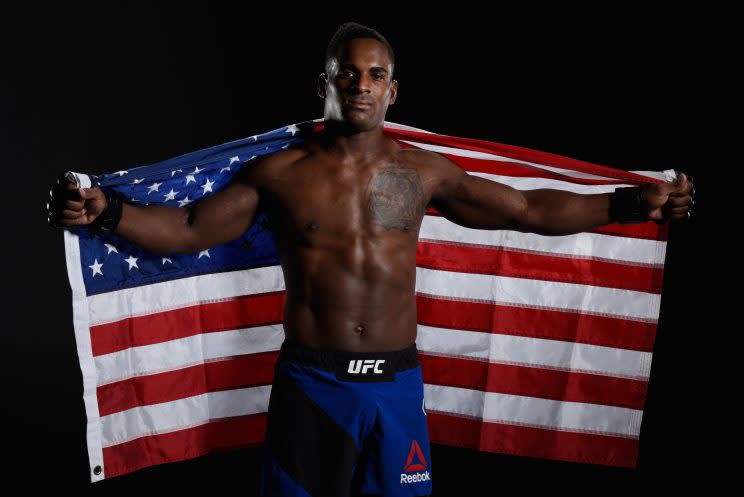Lorenz Larkin's jump to Bellator bulks up roster, and may mean a shift in strategy for UFC's new owners

It’s not like Lorenz Larkin was thinking much about roster depth in the Bellator welterweight division when he decided last week to sign with North America’s second-largest mixed martial arts organization.
Larkin, fresh off back-to-back victories over top 10-ranked fighters Jorge Masvidal and Neil Magny on his way to free agency, had been left twisting for months by the UFC after his contract expired.
So when an attractive offer came through from the Viacom-backed Bellator, the Riverside, Calif., native didn’t hesitate to make the jump.
“It’s about respect,” Larkin told Yahoo Sports. “It wasn’t about who I might be fighting down the road, but more about how things played out. I can’t tell you why [the UFC] did things the way they did, because you’d think they’d be able to market someone with my style who has been winning fights.”
Once the dust settled, though, it became clear the Larkin signing represents something of a tipping point. Bellator’s 170-pound weight class now includes Larkin, champion Douglas Lima, popular Canadian standout Rory MacDonald, hard-hitting British veteran Paul Daley, up-and-coming striker Michael “Venom” Page, and homegrown talents like former champ Andrei Koreshkov and Brennan Ward. Benson Henderson is usually a lightweight, but he jumps up to 170 when the fight is right as well.
“When I finally got around the thinking about it, I realized, yeah, there’s some real talent in this division,” Larkin said. “Go down the list, everyone knows what Rory MacDonald can do, Paul Daley’s been at this a long time, Douglas Lima has been here all along and he wants to prove what he can do. There are a bunch of good fights to be made and I’m excited to play a big role in this.”
This makes Bellator’s welterweight class the best division assembled outside the UFC orbit since the Strikeforce middleweight crew several years back. That roster — which was overseen by Scott Coker, the current Bellator CEO — featured the likes of Luke Rockhold, Ronaldo “Jacare” Souza, Tim Kennedy and Larkin himself.
The UFC’s previous owners, Zuffa, wound up buying Strikeforce in 2011, which was an extension of a philosophy the company held for years. Majority owners Lorenzo and Frank Fertitta, along with president Dana White, wanted to make the UFC the unquestioned leader in the mixed martial arts world, and turn each of their divisions into the unquestioned best in the sport.
An aggressive expansion ensued. The UFC in 2007 purchased the Japanese PRIDE promotion, which for the first half of the 2000s was the world’s most successful MMA promotion. The acquisition brought on board the likes of Antonio Rodrigo Nogueira, Mauricio “Shogun” Rua and Dan Henderson. Another purchase, the short-lived and otherwise forgotten World Fighting Alliance, netted future champs Quinton “Rampage” Jackson and Lyoto Machida. World Extreme Cagefighting, which focused on lighter-weight fighters, was added around the same time, introducing the world to stars like Urijah Faber and Dominick Cruz.
But priorities have clearly changed under new owners WME-IMG, which spent $4 billion to purchase the UFC last summer. Scores of fighters and front-office employees have either been outright cut or had their contracts non-renewed.
While many of those on the wrong end of staffing moves have been fringe players or veterans whose value has clearly maxed out, others are far from it, and that’s enabled the likes of Bellator to make selective additions which have bolstered their roster.
It would be a stretch to say that Bellator’s welterweight division has equaled the UFC’s. Not as long as the UFC continues to feature talent like champion Tyron Woodley, Stephen Thompson, former champ Robbie Lawler, Demian Maia, Carlos Condit, Masvidal, Magny, Donald Cerrone and so on.
But the idea that a competitor would even be allowed to build out a talent base as impressive as Bellator’s welterweight division without a fight is something that would not have flown in the old era.
Larkin, for instance, cannot be dismissed as someone past his prime or unable to hack it in the big leagues. The 30-year-old is 4-1 since dropping down to welterweight, was awarded UFC post-fight bonuses twice during that span and owns a victory over Lawler, albeit during his Strikeforce days at middleweight.
His addition created a path for Bellator to set up a series of welterweight fights as intriguing as anything the other side can offer. MacDonald, in his Bellator debut, will meet Daley in London on May 19. And just Friday, the company announced Larkin will be matched with champion Lima on the main card of their June 24 pay-per-view at New York’s Madison Square Garden.
That’s a pair of consequential fights which could lead to something bigger down the road. But for his part, Larkin isn’t letting himself think about meeting the winner of MacDonald and Daley — not yet at least.
“It’s not like I was guaranteed a title shot when I signed,” Larkin said. “But it was confirmation that I made the right choice. The feedback I’ve gotten from the fans has been great, too. They know what Douglas and I can do.
And Larkin believes other fighters might take a look at his decision — not to mention those of former UFC competitors Ryan Bader and Michael MacDonald, who also signed with Bellator recently — and wonder whether the grass might be greener on the other side.
“I’ve got a title fight, I’ve got an opportunity on a big show, I’m fighting at Madison Square Garden,” Larkin said. “It’s all I could have asked for. I think some fighters on the other side are going to look at this and think this could be them, too.”
Popular MMA video on Yahoo Sports:

 Yahoo Sports
Yahoo Sports 
